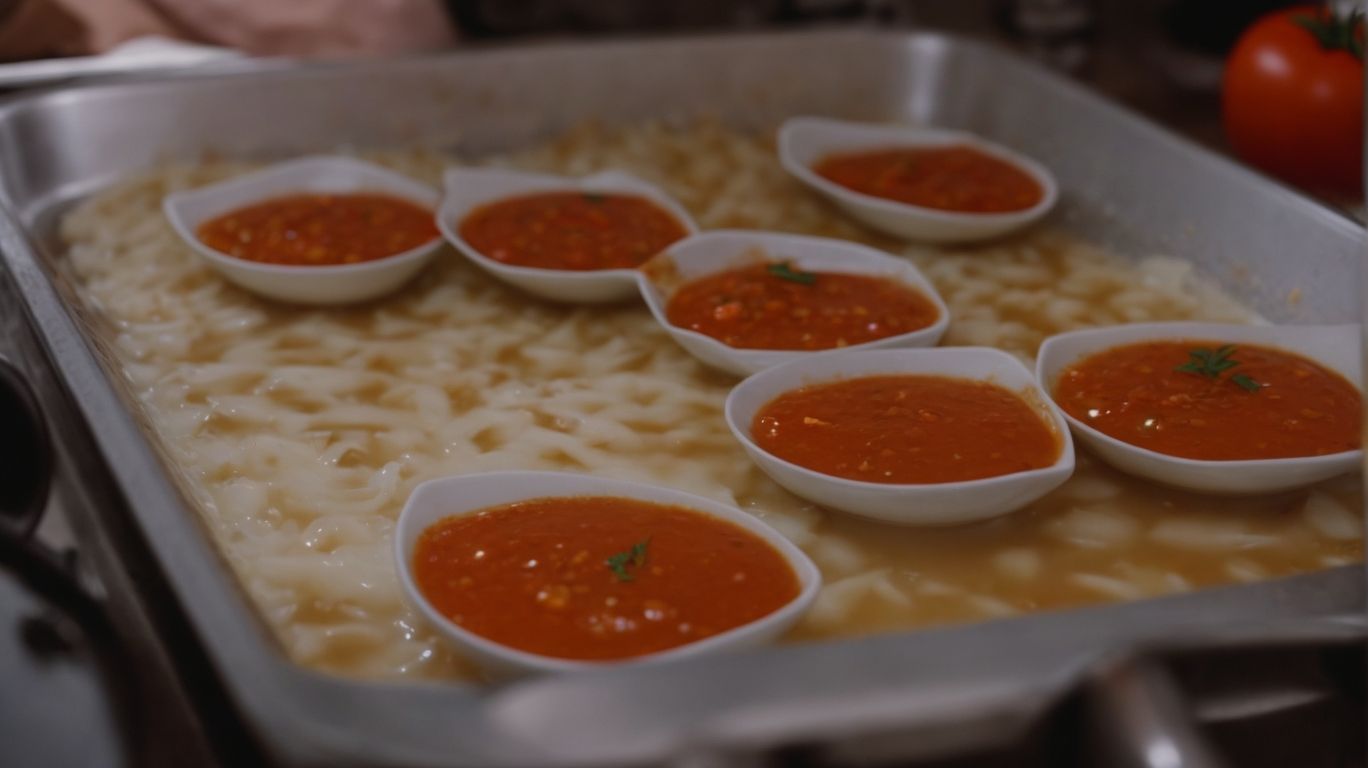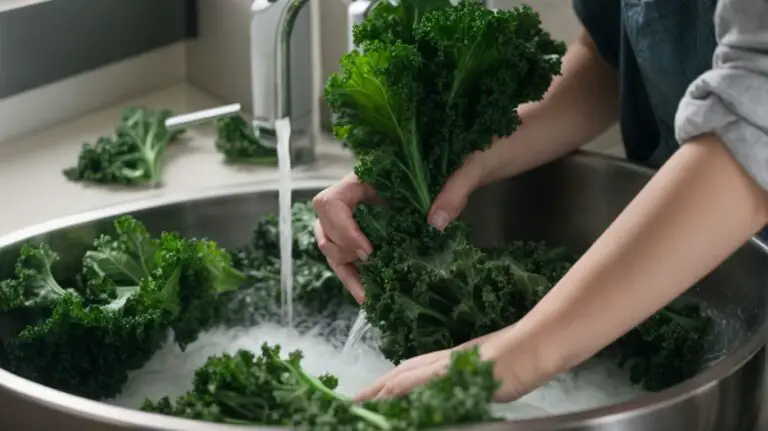How to Cook Roma Tomatoes Into Sauce?
Are you looking to elevate your pasta dishes with a rich and flavorful tomato sauce? Look no further than Roma tomatoes.
We discuss why Roma tomatoes are the perfect choice for sauce, thanks to their high pulp-to-juice ratio, fewer seeds, and intense flavor.
We also provide you with a list of ingredients you’ll need and a step-by-step guide on how to make a delicious Roma tomato sauce.
Stay tuned for tips and tricks to perfect your sauce-making skills. Let’s get cooking!
Key Takeaways:
Why Use Roma Tomatoes for Sauce?

Credits: Poormet.Com – Mason Adams
Roma tomatoes are a popular choice for making sauce due to their high pulp-to-juice ratio, intense flavor, and lower seed and water content.
These characteristics make Roma tomatoes ideal for creating a thick and rich tomato sauce that is perfect for pasta dishes, pizzas, and other culinary creations. Their firm texture holds up well during cooking, allowing the sauce to simmer and develop a concentrated taste. Their fresh taste and vibrant color enhance the overall culinary experience, especially when they are in season. The symphony of flavors that Roma tomatoes bring to a sauce is unmatched, making them a staple ingredient in many kitchens around the world.
High Pulp-to-Juice Ratio
Roma tomatoes stand out for their high pulp-to-juice ratio, making them ideal for thickening sauces and enhancing the overall texture.
Regarding making homemade sauces, such as marinara or pasta sauce, the high pulp-to-juice ratio in Roma tomatoes is a game-changer. This ratio plays a crucial role in determining the sauce thickness and texture. The higher the pulp content, the thicker and richer the sauce will be, imparting a velvety consistency and intense flavor to your dishes.
Cooks often prefer Roma tomatoes for sauce-making due to their ability to reduce faster, resulting in a well-rounded taste without being watery. The concentrated flavor profile created by the pulp ensures that your sauces are bursting with authentic tomato goodness.
Less Seeds and Water Content
Roma tomatoes have lower seed and water content compared to other varieties, which results in a sauce that is more concentrated and flavorful.
This reduced seed and water content in Roma tomatoes is a game-changer when it comes to preparing a rich and intense sauce. With fewer seeds, the pulp of the tomatoes becomes more pronounced, adding a depth of flavor to the sauce. The lower water content means that the tomatoes’ natural sweetness and acidity are more concentrated, enhancing the overall taste profile. When these tomatoes are simmered slowly over low heat with a drizzle of olive oil, their flavors meld together beautifully, resulting in a sauce that is both robust and nuanced.
Intense Flavor
The intense flavor of Roma tomatoes adds a distinct Italian flair to sauces, making them a popular choice for classic Italian dishes.
Roma tomatoes are prized for their rich, slightly sweet taste and dense flesh, which results in a velvety texture when cooked down into a sauce.
Their natural acidity balances well with the fragrant notes of basil and the savory bite of garlic, creating a harmonious symphony of flavors in an authentic Italian dish.
When paired with al dente pasta, the robust flavor of Roma tomatoes truly shines, elevating even the simplest dishes to gourmet levels.
Whether simmered into a marinara, diced for bruschetta, or roasted with olive oil, Roma tomatoes bring a vibrant and robust essence to any Italian culinary creation.
What You’ll Need to Make Roma Tomato Sauce
To make flavorful Roma tomato sauce, you’ll need fresh Roma tomatoes, aromatic garlic, fragrant olive oil, savory onions, and a blend of herbs and spices for that authentic Italian taste.
Starting with fresh Roma tomatoes is crucial as they are known for their rich flavor and minimal seeds, making them ideal for a smooth sauce base. The aromatic garlic adds depth and a hint of pungency, enhancing the overall taste. Fragrant olive oil not only serves as the cooking medium but also brings a subtle fruitiness to the sauce.
Savory onions provide sweetness and balance to the sauce, complementing the tang of the tomatoes. The blend of herbs and spices like basil, oregano, and a touch of red pepper flakes adds complexity and a burst of flavors that elevate the sauce to a new level.
Roma Tomatoes
Roma tomatoes are the star ingredient in Roma tomato sauce, providing a natural sweetness and rich texture when cooked over low heat to achieve the desired sauce thickness.
When making homemade Roma tomato sauce, choosing ripe Roma tomatoes from the store is crucial. The tomatoes are peeled, deseeded, and simmered with garlic, onion, and basil to enhance the flavors. As Roma tomatoes are meatier and have fewer seeds, they thicken the sauce naturally, requiring less cooking time compared to other varieties. The slow cooking process allows the tomatoes to break down, releasing their natural juices and sugars, resulting in a velvety consistency and a burst of fresh, tangy flavor.
Olive Oil
Olive oil is a staple in Roma tomato sauce recipes, adding a rich and smooth texture while infusing the sauce with a touch of Italian authenticity.
When cooking Roma tomato sauce, the choice of olive oil plays a crucial role in elevating the dish to new heights. The simmering process allows the flavors of the tomatoes to meld harmoniously with the olive oil, creating a luscious and hearty base. Not only does the oil enhance the overall taste, but it also offers a velvety consistency that coats each pasta strand perfectly.
The high-quality olive oil imparts a distinct depth of flavor that cannot be replicated by other cooking oils. Its fruity undertones and slight peppery finish complement the natural sweetness of the tomatoes, resulting in a sauce that is both robust and nuanced.
Garlic
Garlic plays a crucial role in Roma tomato sauce, imparting a bold and aromatic flavor that pairs beautifully with pasta and other ingredients.
When sautéed with the Roma tomatoes, garlic releases its rich essence, infusing the sauce with a depth of flavor that is both hearty and savory. The subtle heat and pungency of the garlic perfectly complement the sweet acidity of the tomatoes, creating a well-balanced base for a versatile sauce that can be used in an array of dishes. Combined with fresh basil and a sprinkle of black pepper, garlic elevates the sauce to a whole new level of deliciousness, making it a staple in Italian cuisine and beyond.
Onion
Onions add depth and sweetness to Roma tomato sauce, creating a flavorful base that forms the foundation of a homemade, authentic sauce.
When sautéed slowly until golden and caramelized, onions release their natural sugars and develop complex, savory flavors that harmonize with the acidity of tomatoes. These softened onions nearly melt into the sauce, infusing it with a rich and nuanced taste profile. The combination of onions, along with other ingredients like garlic, herbs, and olive oil, elevates the overall flavor complexity of the sauce, making it more robust and satisfying. To enhance the depth of flavor even further, consider using sweet onions or red onions, depending on your preference.
Herbs and Spices
A combination of fresh basil and a hint of pepper adds a burst of flavor to Roma tomato sauce, elevating its taste and aroma with a perfect balance of herbs and spices.
Herbs like basil bring a refreshing and earthy note to the sauce, while the pepper provides a subtle kick, enhancing the overall depth of flavors. When simmered with garlic-infused olive oil, these ingredients work harmoniously to infuse the tomatoes with a rich, aromatic essence. As the sauce cooks, the basil releases its fragrant oils, perfuming the air with a tantalizing aroma that fills the kitchen.
Step-by-Step Guide to Making Roma Tomato Sauce
Crafting a delicious Roma tomato sauce involves a series of steps, from preparing the tomatoes to simmering them with aromatic ingredients like garlic and onions, resulting in a rich and flavorful sauce that pairs perfectly with al dente pasta.
Begin by selecting ripe Roma tomatoes, known for their meaty texture and low moisture content, ideal for making a thick sauce. Wash and core the tomatoes before scoring an ‘X’ on the bottom, aiding in easy peeling after blanching. Boil water in a pot, blanch the tomatoes briefly, then transfer them to an ice bath to stop the cooking process and facilitate skin removal smoothly. Once peeled, chop the tomatoes and set them aside for the next stages.
Next, heat olive oil in a saucepan over medium heat, adding minced garlic and diced onions to sauté until fragrant. This process infuses the oil with the savory aromas of garlic and onions, enhancing the overall flavor profile of the sauce.
Preparing the Tomatoes
The first step in making Roma tomato sauce is preparing the tomatoes by blanching, peeling, and seeding them to ensure a smooth and velvety texture that pairs beautifully with pasta dishes and grated Parmesan cheese.
Blanching Roma tomatoes involves briefly immersing them in boiling water before transferring them to an ice bath to shock the skin for easy peeling. Once cooled, the skins can be effortlessly removed, revealing the vibrant red flesh underneath.
Peeling the tomatoes ensures a refined consistency in the sauce, free of tough skin pieces that could alter the overall texture. Next, carefully cutting the tomatoes and gently squeezing out the seeds helps prevent any unwanted bitterness.
Olive oil and a well-balanced mix of seasonings are then added to complement the natural sweetness of the tomatoes, resulting in a flavorful base for a delicious sauce. The ingredients are simmered together to meld the flavors and achieve the perfect consistency for a delectable Roma tomato sauce.
Sautéing the Aromatics
Sautéing aromatic ingredients like garlic, tomato paste, and a blend of spices forms the flavorful base of Roma tomato sauce, infusing the sauce with rich and robust flavors that deepen upon simmering.
Adding heat to these aromatic ingredients triggers a chemical reaction that unlocks their full potential, releasing a symphony of flavors that harmonize throughout the sauce.
The process of sautéing not only softens the ingredients but also caramelizes them, creating a depth of sweetness that balances the acidity of the tomatoes.
This crucial step in the sauce recipe allows the flavors to meld together, resulting in a more complex and nuanced taste profile that elevates the overall dining experience.
Adding the Tomatoes
Incorporating fresh Roma tomatoes into the sautéed aromatics is a crucial step in Roma tomato sauce preparation, allowing the flavors to meld and intensify as the sauce simmers to perfection.
As the Italian influence shines through in this sauce-making process, the addition of these vibrant Roma tomatoes brings a burst of freshness and acidity, balancing out the sweetness of the onions and enhancing the overall depth of flavor. The natural juiciness of the tomatoes also aids in achieving the desired sauce thickness, providing a rich texture that clings beautifully to pasta or other dishes. During the simmering stage, the tomatoes break down gradually, releasing their essence into the sauce and creating a velvety-smooth consistency that is characteristic of a traditional Italian tomato sauce.
Simmering and Seasoning
Simmering the Roma tomato sauce with a dash of pepper and fragrant basil allows the flavors to meld and intensify, resulting in a well-seasoned sauce that is perfect for coating your favorite pasta dishes.
Aside from enhancing the flavors, simmering also plays a crucial role in the texture of the sauce. The slow heat helps break down the tomatoes, releasing their natural sweetness and creating a rich, velvety consistency. When you season the sauce during the simmering process, whether with fresh herbs from your garden or aromatic spices from your pantry, the heat allows these ingredients to infuse the sauce, elevating it to a whole new level of deliciousness.
Tips and Tricks for Perfect Roma Tomato Sauce
Achieving the perfect Roma tomato sauce requires choosing ripe tomatoes, using a food mill for a smooth texture, sautéing aromatics for depth of flavor, and experimenting with a variety of herbs and spices like basil for enhanced taste.
To elevate the quality of your Roma tomato sauce, ensure you select tomatoes that are firm yet yielding slightly to pressure, as they contain the perfect blend of sweetness and acidity. Once you have your ripe tomatoes, run them through a food mill or peel and deseed them manually to achieve a velvety, lump-free texture.
For an added layer of complexity, infuse your sauce with the rich flavors of sautéed garlic, onions, and carrots. These ingredients not only enhance the taste but also provide a robust base for your sauce.
Experiment with different herbs like oregano, thyme, and rosemary, along with a pinch of red pepper flakes for a subtle kick. Taste as you go, adjusting seasoning and salt levels to achieve a well-balanced flavor profile that suits your palate.
Choose Ripe Tomatoes
Selecting ripe Roma tomatoes at the peak of their season ensures a sweet and vibrant flavor for your tomato sauce, enhancing the sauce’s overall taste and freshness when simmered to perfection.
Regarding making a delicious homemade pasta sauce, the choice of tomatoes plays a crucial role in achieving that ideal balance of sweetness and acidity. The Roma tomato, also known as the Italian plum tomato, is particularly prized for its meaty texture and low seed count, making it a popular option for sauce-making.
The heat of the summer sun ripens these tomatoes to perfection, intensifying their natural sugars and giving them a deep, rich flavor that shines through in every bite of your sauce. This seasonal ripeness not only enhances the taste but also ensures that your sauce is packed with nutrients and antioxidants, making it both flavorful and nutritious.
Use a Food Mill for a Smooth Sauce
Passing the cooked Roma tomatoes through a food mill results in a velvety smooth sauce that captures the essence of the tomatoes and elevates the overall cooking experience.
By using a food mill, you effortlessly control the sauce thickness, ensuring it’s just the way you like it. The gentle grinding action of the mill effectively breaks down the tomatoes, extracting their rich flavor without compromising on texture. This method also allows you to regulate the heat during the preparation process, preserving the delicate balance of flavors in the sauce. Incorporating a drizzle of high-quality olive oil while milling the tomatoes enhances the taste profile, adding a touch of richness and depth.
Don’t Skip the Sautéing Step
Sautéing the aromatics like garlic and onions before adding the Roma tomatoes is essential to develop the foundational flavors of the sauce, creating a robust base with layers of taste that intensify when cooked over gentle heat with a touch of basil.
By cooking the aromatics first, you allow them to release their natural oils and aromatic compounds, infusing the sauce with a rich depth of flavor. This initial step sets the stage for the tomatoes to showcase their sweet and tangy notes, typical of Italian cuisine. As the ingredients meld together, the sauce transforms into a harmonious blend where the acidity of the tomatoes balances the earthy sweetness of the sautéed garlic and onions.
Experiment with Different Herbs and Spices
Exploring a variety of herbs and spices such as basil and pepper allows one to customize the flavor profile of their Roma tomato sauce, adding a creative touch and personal flair to culinary creations.
For those looking to infuse their Roma tomato sauce with a burst of freshness, consider incorporating fresh garlic along with basil for a zesty kick. Alternatively, for a cozy and warming aroma, a dash of cinnamon and a hint of nutmeg can transform your sauce into a comforting delight. To bring a bit of heat, a pinch of red pepper flakes or a sprinkle of paprika can do wonders. Don’t be afraid to step out of your comfort zone and experiment with cumin, oregano, or thyme to discover new dimensions of flavor. Remember, the key lies in balancing these flavors to create a rich and harmonious Roma tomato sauce that will leave your taste buds singing.
Conclusion

Credits: Poormet.Com – Russell Walker
Roma tomatoes are the secret ingredient behind a delectable tomato sauce that elevates pasta dishes with their rich flavor and versatile culinary applications.
When creating a savory tomato sauce from scratch, Roma tomatoes are often the go-to choice due to their dense flesh, low moisture content, and fewer seeds, which ensure a thick and robust texture. Whether you are making a quick marinara sauce for a weeknight meal or a slow-simmered ragù for a special occasion, Roma tomatoes bring depth and complexity to the sauce. Their distinct sweetness intensifies as they cook, enhancing the overall flavor profile and aroma. A classic sauce recipe usually involves gently simmering Roma tomatoes with garlic, olive oil, herbs, and seasonings until they break down into a luscious sauce that pairs perfectly with al dente pasta.
Frequently Asked Questions
1. How do I prepare Roma tomatoes for making sauce?
To prepare Roma tomatoes for sauce, first wash them thoroughly and remove the stems. Then, cut a small “X” on the bottom of each tomato. This will make it easier to peel the skin off after blanching.
2. Can I use canned Roma tomatoes for sauce?
Yes, you can use canned Roma tomatoes for sauce. However, fresh Roma tomatoes will give your sauce a fresher and more vibrant flavor. If using canned tomatoes, make sure to drain them before adding to the sauce.
3. How long should I cook Roma tomatoes into sauce?
The cooking time for Roma tomatoes into sauce can vary depending on the recipe and the desired consistency. However, on average, it takes about 30-45 minutes to cook Roma tomatoes into a thick sauce. Make sure to stir occasionally to prevent burning.
4. Should I remove the seeds of Roma tomatoes for sauce?
It is not necessary to remove the seeds of Roma tomatoes for sauce. However, if you prefer a smoother texture, you can remove the seeds by cutting the tomato in half and scooping them out with a spoon before cooking.
5. Can I freeze Roma tomato sauce?
Yes, you can freeze Roma tomato sauce. Allow the sauce to cool completely before transferring it to an airtight container or freezer bags. It can be stored in the freezer for up to 6 months. To use, thaw in the refrigerator overnight and reheat on the stovetop.
6. Are there any herbs or spices that pair well with Roma tomato sauce?
There are many herbs and spices that pair well with Roma tomato sauce, such as basil, oregano, thyme, and garlic. You can also add some red pepper flakes for a bit of heat or a dash of sugar to balance out the acidity of the tomatoes. Experiment with different flavors to find your perfect combination.



